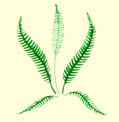The Fernhurst Society
Newsletter no 50, July 2019
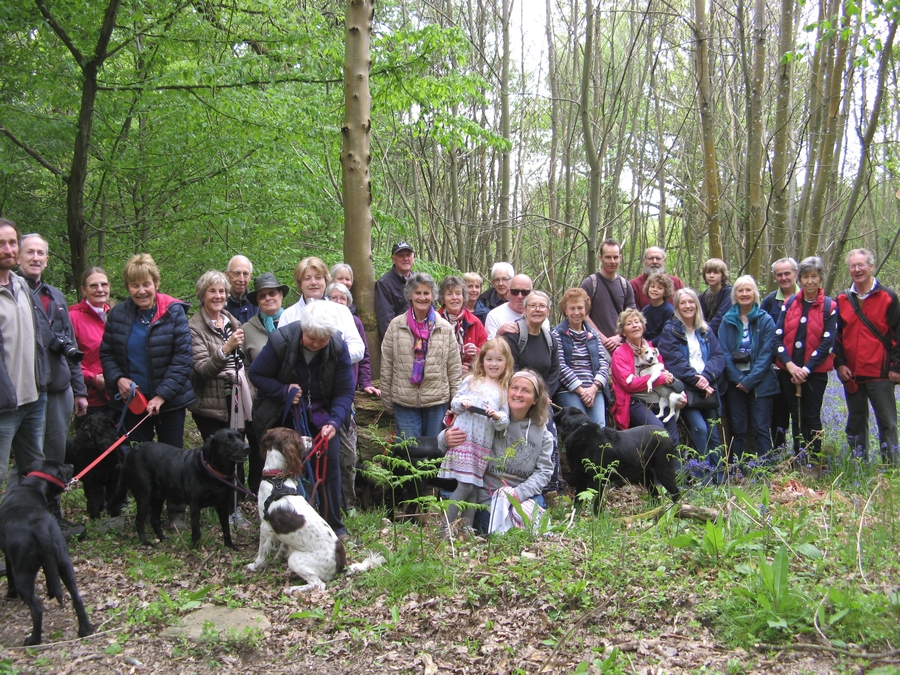
Bob’s Bluebell Bimble 28 April 2019:
As ever, a highly successful expedition for all ages on 2 and 4 legs, led by Bob Smalley.
Special thanks to Brenda Newman for the lovely photo.
Bob’s next walk is Sunday 20 October.
Dates for your diary
| Sat 14 and
Sun 15 Sept 10.30 – 5pm |
Fernhurst Furnace Open Weekend
Organised by the Fernhurst Furnace Preservation Group. This is always a great weekend of activities, usually with a living history society and the Sealed Knot in attendance. Free entry, free parking. Donations welcome. All donations go towards preserving this special site. More information www.fernhurstfurnace.co.uk |
| Thu 20 Oct Meet Crossfield Car Park 1.20pm |
Walk: The Punch Bowl without the Punch
We’ll bundle into as few cars as possible and head up to Hindhead National Trust car park. A circular walk of about 2 hrs around Hindhead Common and the Devil’s Punch Bowl. Dogs welcome. Flat with some gentle climbs. Magnificent views towards London from The Cross. Then get yourself some tea and buns in the National Trust café. |
| Thu 31 Oct Village Hall 7.30pm for 8pm |
Talk: The history of Midhurst
Tim Rudwick, of the Midhurst Society, will talk on the rich history of the town. |
| Thu 29 Nov Village Hall 7pm for 7.30pm NOTE EARLIER START |
AGM and talk: Pevsner Architectural Guide to West Sussex Jeremy Musson (writer, broadcaster and former architectural editor of Country Life) will talk about his recent work revising the Pevsner Architectural Guide to West Sussex. |
Didlesfold - a Fernhurst Manor
For hundreds of years, the people of Fernhurst, like many other country dwellers, lived under the manorial system with most land and property effectively owned by the Lord of the Manor or rather Lords of the Manors in Fernhurst’s case.
The Manors that lie in, or extended into, the Parish of Farnhurst were Didlesfold, Verdley, Cowdray, Easebourne Priory, Farnhurst and Woolavington, and the Liberty of St. John (Moses Hill Farm area).
An isolated strip of North Ambersham was absorbed into Fernhurst Parish in the early 20th century, but in earlier centuries it belonged to the Hampshire Parish of Steep, and the Manor of West Meon.
Didlesfold/Dudlesfold/Diddlesfold Manor
Didlesfold or Dudlesfold Manor (today spelt Diddlesfold) stretched from Cooksbridge in the south to the County boundary in the north; largely lying on the east side of the A286.
Diddlesfold Manor was in two parts; the Fernhurst or Western Division, and the Lurgashall & Northchapel or Eastern Division, separated by the mysterious strip of North Ambersham, which lay in the Manor of West Meon.
Court proceedings
A record of the Courts’ proceedings from 1744 through to 1878 has been discovered by the Archive Team at Haslemere Museum. The Curator has kindly allowed the Team to digitally scan the document, a hard copy of which is in preparation for deposit in the Archive.
The three courts
Disputes between tenants or, more rarely, between tenant and Lord were tried by courts held periodically in the Manor House. Under the name “Manorial Court” there were 3 courts:
- Court Leet and View of Frankpledge
- Court Baron and
- Customary Court.
The Court Leet (View of Frankpledge) was a court of criminal jurisdiction in which the Lord of the Manor was empowered by the Crown to deal with infringements of the Common Law, not grave enough to be brought before the higher courts.
The Court Baron and Customary Court, which were soon amalgamated, sat for the receipt of customary dues (rents) from the tenants of the Manor, and for the judgement of domestic issues concerning trespass, debts, unlawful cutting of timber, unlawful diversion of watercourses, infringements of the rights over Common land etc.
Each Court comprised the tenants of the Manor, presided over by the Lord of the Manor, or his representative, the ‘Reeve’, so tenants were judged by their peers. The seeds of our present democracy were possibly sown in this system.
Lords of the Manor
From 1744 through to 1838, the Lords of the Manor of Didlesfold were the Yaldwyns or Yaldens, the Ironmasters from Blackdown House.
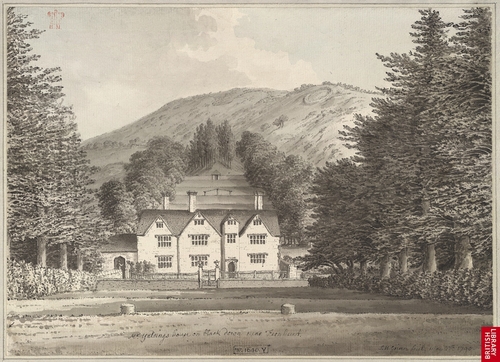
Mr. Yaldings House, Blackdown, Nr. Fernhurst, Sussex, 27 May 1790.
Watercolour by Grimm, ref-sx450. Courtesy, British Library
In 1838 the Manor was purchased by George Baker of Northchapel. The Baker family lived at Broadlands in Fisherstreet (north of Northchapel) and at Diddlesfold Manor Farm in Northchapel, which was the Court House from that date.
The Court Book records
The Court Book records the misdemeanours of the tenants and their penalties, such as exceeding ‘rights of common’ – the rights tenants had to allocated common land (see below).
The Court Book also recorded the death of tenants in possession and their ‘heriots’, a form of death duty requiring the deceased’s family to surrender their ‘best beast’ (horse, cow, pig etc.) to the Lord of the Manor and ‘Alienations’ (the transfer of property rights such as copyholds).
A record of the periodic ‘treading’ of the bounds of the Manor is also included, with a full description of the perambulation, essential to asserting the extent of the Lord of the Manor’s domain. It is challenging to trace the Manor boundaries from these perambulations as transient landmarks, such as pollarded trees, are often used.
The document is a fascinating snapshot of life under this feudal system.
Robin Ellks
Fernhurst Archives
Rights of Common and Waste of the Manor
There is a common misunderstanding that ‘Commons’ are commonly owned by everyone. This was never the case. Common Land, in the time of the manorial system, was owned by the Lord of the Manor who gave tenants rights to make use of designated Common Land (including pasture and arable) and the ‘Waste of the Manor’ (land not in use by the Lord). For example, a tenant may be granted the right to graze two cows on the Common or take a certain amount of bracken for animal bedding, or stone from the ‘Waste’. Below are some entries from the Diddlesfold Court Book where people have helped themselves to materials or land that they were ‘not entitled to’.
1748 “The road or highway leading by a place called
Friday’s Hill near to the grounds of Peter Bennett
within the Manor is by this space of … yards very
much impaired and a common nuisance by reason of
John Marshall having lately dug several quantities of
stones there and carried them away. This Court
orders that unless the said John Marshall so
sufficiently repair the road before the next Court the
said John Marshall shall forfeit and pay to the Lord
of the Manor the sum of ten shillings”.
1748 “Richard Luff hath enclosed and taken in part of
the Waste of this Manor adjoining Sopers Coppice. He
is ordered to throw the same out again before the
next Court to be holden for the said Manor upon pain
of forfeiting to the Lord of the Manor the sum of ten
shillings.”
1790 “John Humphrey of Farnhurst, Carpenter, has since the last Court made an encroachment on the Waste of the Manor by inclosing a part of the said Waste adjoining Farnhurst Churchyard. The homage (Court) order that the said John Humphrey pay for the same to the Lord of the Manor the sum of one penny.”
1790 “Thomas Smith of Farnhurst, Wheelwright, has since the last Court made an encroachment of the Waste of this Manor by erecting a hogpen on part of the Waste next to the Wheelwright’s shop now in his occupation. The homage order that the said Thomas Smith pay for the same to the Lord of the Manor the sum of one penny.”
Robin Ellks
Fernhurst Archives
News from the Archive
A varied month - from visitors and visits to our ongoing project of scanning unique documents such as the school log books.
A house historian who was researching Verdley Edge came in and there was a mutual exchange of info and photographs. She has promised us a copy of her report when it is completed.
Brian Silver came in re family photos, and Peter Taylor who was interested in Hawksfold House.
Kathleen and Christine spent a delightful afternoon with lifelong Kingsley Green/Fernhurst resident Kath Wright and came away with many interesting and useful photos and press cuttings.
Two visitors came in researching the Fernden Lane/Green Lane area of Bell Vale and Robin Ellks was on hand to help them.
Kathleen had a meeting with Esther Collins who donated some Ultramar/Q8/Farm Fuels memorabilia, pic of the (new) Spread Eagle being demolished and various press cuttings from 1984 and 2004.
Christine attended a ‘How to read old handwriting’ course at WSRO and found it very interesting and the supporting documents will come in very handy as well.
We have been concerned in the Archive about fire safety, for the volunteers as well as the collection. Christine had a meeting with Stuart Webber, who was able to assure that the smoke alarms were regularly tested and that our present door was fireproof for at least twenty minutes. He is going to try and arrange some training on how to use the two types of fire extinguishers we have, but added that it’s better to get out of the building rather than try to fight any blaze!
Christine Maynard
Fernhurst Archives
THE FERNHURST ARCHIVESOpen Tuesdays between 2.30pm and 5pm, we’re upstairs in the Village Hall (side entrance). We have a substantial archive of photographs and documents and some artefacts. We welcome enquiries on local history, buildings, archaeology and genealogy in person or by email. If you wish to visit, do contact Christine Maynard
beforehand by phone 653663 or email the address
below - it helps us to have the relevant information
ready for you. |
Discoveries on the walk around historic Petersfield
We learnt many things on our walk from our Petersfield Museum guide. Petersfield is not called after anyone named Peter, but after a chapel of rest for the workers who could not get back to the far more important conurbation of Buriton for their prayers.
A natural crossing place of routes from Winchester to Chichester and from Portsmouth to London surrounded by good farming land for sheep - hence markets, butchers, shambles, roads called Sheep Street, tanneries, foreign traders and an excess of pubs, which as trade increased became carriage inns because of the need to change horses, later becoming hotels for the tourist trade.
Famous people, Flora Twort the artist; John Small who straightened the cricket bat (google him!) Churcher of school fame; Austen of Jane fame who ran a bank which failed; Commander Loftus Jones V.C.; John Goodyear the botanist, and a mass of famous stayed there on journeys! Far too many old beautiful houses demolished and replaced with horrific modern monstrosities, road routes changed but medieval workings still visible in many places.
Very interesting. But look up when you wander through the town, not down!
Judith Turner
Fernhurst Burials Project
The Fernhurst Archive Team were so impressed with work carried out by Lodsworth on recording, photographing and mapping their church graveyard and, after consultation with the Parish Council and the Vicar of St Margaret’s, resolved to try something similar.
In Fernhurst we have burials in a municipal burial ground, as well as in the churchyard.
St Margaret’s Church
St Margaret’s Church was built in the 12th century. It’s quite possible it’s not the first church on the site as the name of our village is Saxon in origin. Thereby, it’s likely that there have been burials in the churchyard for over a thousand years. Records for the churchyard burials date back to the sixteenth century and are held at the West Sussex Record Office.
Fernhurst and North Ambersham* Burial Ground
The burial ground in Church Road was opened in 1879 (blue border in map below) following various Acts of Parliament that required local authorities to provide burial space; acknowledging the shortage of burial space in churchyards and a requirement for areas not consecrated by the Church of England. Our burial ground is managed by Fernhurst Parish Council and has consecrated and unconsecrated areas. Burial grounds differ from cemeteries in that they are smaller. Fernhurst burial ground was extended in the mid twentieth century (red border) and is now commonly referred to as Fernhurst cemetery.
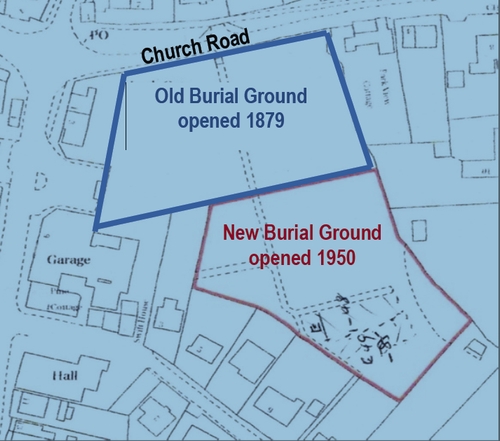
Get involved
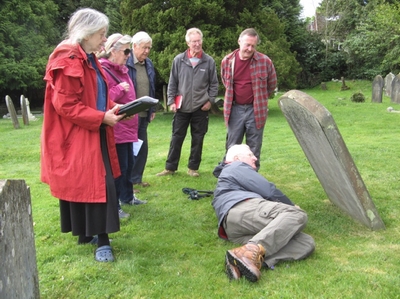 Contact Iain Brown at the
Fernhurst Archives or
elaine.ireland@btinternet.com
Contact Iain Brown at the
Fernhurst Archives or
elaine.ireland@btinternet.com
We’re looking for:
- photographers to photograph the memorials
- volunteers to go into the burial grounds and record the inscriptions
- typists to transcribe handwritten burial registers and memorial inscriptions.
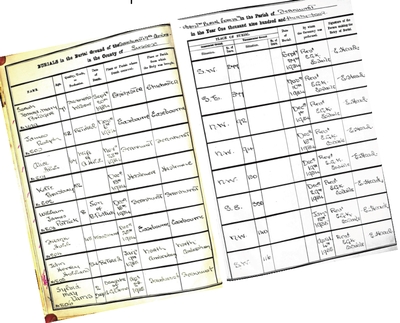
We have a few teams ‘up and running’ and have almost completed recording the red area of the map. Our next step is to get hold of the records for the blue area (from West Sussex Record Office) and make a start in the northern part of the cemetery.
* North Ambersham?
Long-standing members of the Fernhurst Society will know of David Coward’s research work on North Ambersham – a sliver of Hampshire in West Sussex. North Ambersham was absorbed into the parishes of Fernhurst, Lurgashall and Lodsworth by the early 20th century but was still in existence when the Fernhurst and North Ambersham Burial Ground was opened.
